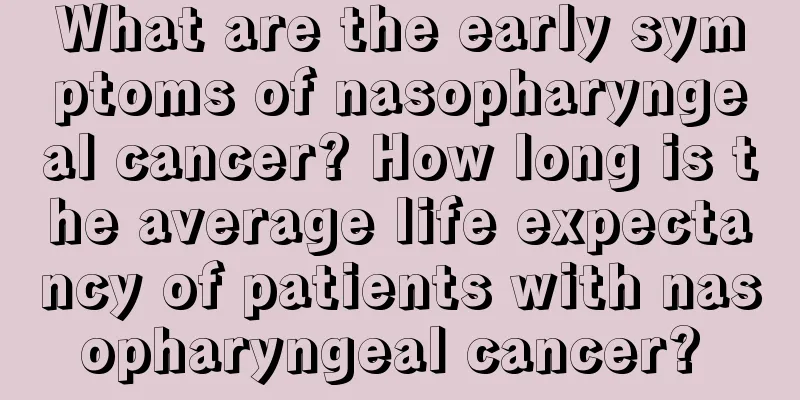What are the early symptoms of nasopharyngeal cancer? How long is the average life expectancy of patients with nasopharyngeal cancer?

|
Nasopharyngeal carcinoma is a type of cancer that occurs in the nasopharynx or upper throat and has a high mortality rate. In some parts of the world, such as Guangdong, Southeast Asia and Africa, more people suffer from this disease than in other places. In the past, it was believed that it was mainly due to the influence of diet, but now it tends to be mainly affected by genetic genes. (I) Regurgitation of blood in the nose In the early stage, there may be bleeding symptoms, which are manifested as blood in the sputum after suctioning the nose or blood in the mucus when blowing the nose. In the early stage, there is only a small amount of blood in the sputum or mucus, which sometimes appears and sometimes disappears. In the late stage, there is more bleeding, and there may be nosebleeds. (ii) Tinnitus, hearing loss, and a feeling of blockage in the ear When nasopharyngeal carcinoma occurs in the lateral wall of the nasopharynx, the lateral fossa, or the upper lip of the Eustachian tube opening, the tumor compresses the Eustachian tube and may cause unilateral tinnitus or hearing loss, and catarrhal otitis media may also occur. Deafness and a feeling of blockage in the ears are one of the early symptoms of nasopharyngeal cancer. (III) Headache It is a common symptom, accounting for 68.6%. It can be the first symptom or the only symptom. In the early stage, the headache location is not fixed and intermittent. In the late stage, it is a continuous migraine with a fixed location. The reason is that early patients may It is caused by neurovascular reflex or stimulation of the first branch of the trigeminal nerve. In advanced cases, it is often caused by tumors destroying the skull base and spreading inside the skull to affect the cranial nerves. (IV) Diplopia The tumor invades the abducens nerve, which often causes double vision when looking outward. The invasion of the trochlear nerve often causes inward strabismus and diplopia, which accounts for 6.2% to 19%. It is often damaged at the same time as the trigeminal nerve. (V) Facial numbness Refers to numbness of the facial skin. Clinical examination shows decreased or absent pain and touch sensation. Tumor invasion of the cavernous sinus often causes damage to the first or second branch of the trigeminal nerve; tumor invasion of the oval foramen, the anterior styloid process, and the trigeminal nerve The third branch often causes numbness or paresthesia in the front of the auricle, temporal region, cheek, lower lip and chin. Numbness of the facial skin accounts for 10% to 27.9%. 6. Nasal congestion If the tumor blocks the posterior nostril, nasal congestion may occur. When the tumor is small, the nasal congestion is mild. As the tumor grows, the nasal congestion becomes more severe, usually unilateral. If the tumor blocks both posterior nostrils, bilateral nasal congestion may occur. (VII) Symptoms of cervical lymph node metastasis Nasopharyngeal carcinoma is prone to cervical lymph node metastasis, accounting for about 60.3% to 86.1%, of which half are bilateral metastasis. Cervical lymph node metastasis is often the first symptom of nasopharyngeal carcinoma (23.9% to 75%). A small number of patients No primary lesion could be found in the nasopharynx, and cervical lymph node metastasis was the only clinical manifestation, which may be related to the small size of the primary lesion of nasopharyngeal carcinoma and its extension into the submucosal tissue. 8. Tongue muscle atrophy and tongue deviation Nasopharyngeal carcinoma directly invades or lymph nodes metastasize to the posterior styloid process or hypoglossal nerve canal, causing the hypoglossal nerve to be invaded, causing the tongue to deviate to the affected side, accompanied by atrophy of the tongue muscles on the affected side. (IX) Eye ptosis and fixed eyeball Related to oculomotor nerve damage. Visual impairment or loss is related to optic nerve damage or orbital cone invasion. 10. Distant metastasis The distant metastasis rate of nasopharyngeal carcinoma is about 4.8% to 27%. Distant metastasis is one of the main reasons for the failure of nasopharyngeal carcinoma treatment. Common metastatic sites are bones, lungs, liver, etc., and simultaneous metastasis to multiple organs is common. (XI) Associated dermatomyositis Dermatomyositis may also occur with nasopharyngeal carcinoma, so the nasopharynx should be carefully examined for patients with dermatomyositis regardless of whether they have symptoms of nasopharyngeal carcinoma. (XII) Menopause It is very rare as the first symptom of nasopharyngeal carcinoma and is related to nasopharyngeal carcinoma invading the sphenoid sinus and pituitary gland. The nasopharynx is deep and hidden. The local symptoms of malignant tumors in this area are not obvious. They are often noticed only after they spread to adjacent structures or lymphatic metastasis. They are first noticed because of orbital pain, extraocular muscle paralysis and proptosis. Nasopharyngeal carcinoma can be divided into three main types at the microscopic level: keratinizing carcinoma, non-keratinizing carcinoma and undifferentiated type. Family factors: If someone in the family suffers from nasopharyngeal cancer, the chances of other family members getting the disease also increase, especially first-degree relatives. Lifestyle and environmental factors: Frequent consumption of pickled or smoked foods: Nasopharyngeal cancer is more common among Chinese and Eskimos, with a much higher risk of disease than Europeans, Americans, Japanese and Koreans. Residents of China's southeastern coastal areas and Taiwan have a higher risk of disease than those in northern China, especially in Guangdong. Therefore, it is also known as "Guangdong cancer." Even overseas Chinese have a higher risk of disease than locals. In the past, it was generally believed that this was closely related to the consumption of salted fish, because salted fish contains carcinogens such as nitrosamines. However, this statement cannot explain why immigrants who have moved abroad and no longer have the habit of eating salted fish and their descendants still have a high risk of disease, and those who moved to Guangdong from other places and have the habit of eating salted fish do not have a high risk of disease. Therefore, it is now generally believed that genetic genes are the main pathogenic factors affecting nasopharyngeal cancer. [1] Long-term inhalation of irritants from smoking, such as industrial asbestos, chromium, nickel, etc. Poor ventilation in the workplace EB virus research shows that the types and levels of anti-EB virus antibodies in the serum of nasopharyngeal carcinoma patients are higher than those of ordinary people. Most people in southern China have a history of contact with EB virus. Although most people will not develop the disease in their lifetime, a small number of people will develop the disease after being exposed to a special external environment, which causes the body's immune system to react with the EB virus. As for the mechanism by which EB virus causes nasopharyngeal carcinoma, further research is needed. Other men are three times more likely to develop the disease than women. People with a history of sinusitis are also more likely to develop the disease than the general population. In people's daily life, it is very beneficial to take preventive measures from the following aspects: 1. Avoid being exposed to heavily polluted external air as much as possible. Because the nasopharynx is the only way for external air to enter the lungs, harmful gases first invade the nasopharynx before entering the lungs. 2. Quit smoking and drinking. 3. Pay attention to your diet structure, don't be picky eaters, eat more vegetables, fruits and other foods that contain a lot of vitamins. Eat less or no salted fish, pickled meat, etc. General treatment 【treat】 1. Radiotherapy Radiotherapy has always been the first choice for treating nasopharyngeal carcinoma. The reason is that most nasopharyngeal carcinomas are poorly differentiated cancers with high sensitivity to radiation, and the primary lesions and the neck lymphatic drainage area are easily included in the irradiation field. Since the 1940s, my country has carried out deep X-ray radiotherapy for nasopharyngeal carcinoma. Since the 1950s and 1960s, 60Co external beam radiotherapy has been carried out, and the combined large field irradiation of the nasopharynx and neck has been changed to small field irradiation, which reduces radiotherapy reactions and improves survival rates. At present, the most effective and most certain method is to use a 60Co teletherapy machine. 1. Indications and contraindications for radiotherapy of nasopharyngeal carcinoma (1) Indications for radical radiotherapy Patients with above-average general condition; no obvious bone destruction at the skull base; no or only mild to moderate infiltration near the nasopharynx shown on CT or MRI; cervical lymph nodes with a maximum diameter of less than 8 cm, active and not reaching the supraclavicular fossa; ⑤ no distant organ metastasis. (2) Indications for palliative radiotherapy Patients with KS grade of 60 or above, severe headache, moderate or above nasopharyngeal bleeding, single distant metastasis or cervical lymph node metastasis larger than 10 cm. If the general condition improves after palliative radiation, symptoms disappear, and distant metastasis can be controlled, radical radiation therapy can be used. (3) Contraindications to radiotherapy KS grade below 60 points; patients with extensive distant metastasis; patients with concurrent acute infection; patients with radiation-induced brain and spinal cord injury. (4) Principles of re-irradiation after recurrence after radiotherapy Radiotherapy should not be performed again in the following cases: The recurrence time after radiotherapy in the same target area (including nasopharyngeal and cervical target areas) is less than one year; Radiation encephalopathy or radiation myelopathy occurs after radiotherapy; The total treatment course for the nasopharyngeal target area should not exceed three courses, and the total treatment course for the cervical target area should not exceed two courses. 2. Choice of radiation and irradiation range (1) Design of irradiation field: The principle of designing irradiation field is "small but not leaking". All parts affected by the tumor should be included in the irradiation field, but normal tissues in the irradiation field, especially those sensitive to radiotherapy, should be protected. For primary lesions in the nasopharynx, the bilateral preauricular fields are mainly used. If the nasal cavity and paranasopharyngeal space are involved, the prenasal field can be added. If the orbit is involved, the supraorbital field or infraorbital field can be added. Pay attention to using lead sheets to protect the eyes to prevent radiation cataracts. The irradiation range of the neck depends on the lesions of the lymph nodes. For those whose cervical lymph nodes are not involved, preventive irradiation of the upper neck area on both sides is often performed. If there is cervical lymph node metastasis, in addition to irradiating the metastatic lesions, preventive irradiation of the drainage area below the metastatic lesions is often performed. 3. Radiation dose and duration (1) Continuous radiotherapy: 5 times a week, 200 cGY each time, total amount TD6000-7000 cGY/6-7 weeks. (2) Fractional radiotherapy: Radiotherapy is generally divided into two sessions, 5 times a week, 200 cGY each time, and each session lasts about 3.5 weeks. There is a four-week break between the two sessions, and the total dose is TD6500-7000 cGY. 4. Afterloading intracavitary radiotherapy (1) Indications ① Small localized lesions in the nasopharynx (tumor thickness less than 0.5 cm), located on the top wall, anterior wall or lateral wall; ② Residual lesions after external irradiation or surgical resection of nasopharyngeal carcinoma that meet item ①. (2) Treatment method: It is usually a combination of external radiation and intracavitary radiation, with an external radiation dose of 4500-6000 cGY. After 1-2 weeks of external radiation, intracavitary radiation is added 1-2 times, with an interval of 7-10 days between each time. Each dose is given at 0.25 cm below the mucosa, with a dose of 1000-2000 cGY/time. 5. Radiation reactions and regression and their treatment (1) Complications of radiotherapy ① Systemic reactions: including fatigue, dizziness, decreased appetite, nausea, vomiting, tastelessness or change in taste in the mouth, insomnia or drowsiness, etc. Some patients may experience changes in blood count, especially leukopenia. Although the degree varies, it can generally be overcome through symptomatic treatment and radiotherapy can be completed. If necessary, vitamin B1, B6, C, metoclopramide, etc. can be taken. If the white blood cell count drops below 3×109, radiotherapy should be suspended. ② Local reactions: including reactions of the skin, mucous membranes, and salivary glands. Skin reactions manifest as dry dermatitis or even wet dermatitis, and anti-inflammatory ointments with 0.1% borneol talc or lanolin as the base can be used topically. Mucosal reactions manifest as congestion, edema, exudation, and accumulation of secretions in the nasopharyngeal and oropharyngeal mucosa, and gargles and lubricating anti-inflammatory agents can be used topically. In a small number of patients, parotid swelling may occur after 2Gy of parotid irradiation, and the swelling gradually subsides in 2 to 3 days. When irradiated with 40Gy, saliva secretion is significantly reduced, while oral mucosal secretion increases, and the mucosa becomes congested and swollen. Patients have dry mouth and difficulty eating dry food. Therefore, excessive irradiation of the parotid gland should be avoided. (2) Post-radiotherapy syndrome: mainly temporomandibular joint dysfunction and soft tissue atrophy and fibrosis, radiation-induced dental caries, radiation-induced osteomyelitis of the jaw bone, and radiation-induced encephalomyelopathy. There is currently no proper way to reverse these symptoms, but symptomatic treatment and supportive measures can be helpful to a certain extent. Excessive irradiation of important tissues and organs must be strictly avoided. (ii) Surgical treatment 1. Resection of primary lesion of nasopharyngeal carcinoma (1) Indications ① Highly differentiated nasopharyngeal carcinoma, such as adenocarcinoma, squamous cell carcinoma grade I and II, and early cases of malignant mixed tumors. ② Local recurrence of the nasopharynx after radiotherapy, the lesions are limited to the posterior or anterior wall of the pharynx, or only involve the edge of the pharyngeal recess, without infiltration of other parts, no difficulty in opening the mouth, and the physique is still good. ③ If a radical dose of radiotherapy has been given and the primary nasopharyngeal lesion has not disappeared or radiation resistance has occurred, surgical resection can be performed after a month of rest. (2) Contraindications ① Patients with skull base bone destruction or paranasopharyngeal infiltration, cranial nerve damage or distant metastasis. ② Those with poor liver and kidney function and poor general condition. (3) Surgical method: Perform tracheotomy and intubation first, and then perform surgery under general anesthesia. Make a horseshoe-shaped incision along the inner side of the palatal tooth root 0.5 cm away from the alveolar ridge, cut the hard pelvic mucosa, peel under the mucosa to the soft palate, and remove part of the hard pelvic bone plate and vomer. Make a transverse incision of the nasal floor mucosa at the junction of the hard and soft palate to expose the top wall of the nasopharyngeal cavity, the anterior part of the two sides of the wall, and the tumor. Make a cut in the nasopharyngeal mucosa at the posterior edge of the nasal septum and the upper edge of the posterior nasal cavity to the bone surface, perform blunt or sharp separation, and cut along the junction of the nasopharyngeal top and side, and cross-cut the mucosa down to the junction of the oropharynx and the posterior wall of the nasopharynx, and remove the entire posterior nasopharyngeal mucosa together with the tumor. 2. Neck lymph node dissection (1) Indications If the primary nasopharyngeal cancer lesion has been controlled after radiotherapy or chemotherapy, the patient is in good general condition, and only residual or recurrent lesions in the neck remain, which are localized and active, cervical lymph node dissection may be considered. (2) Contraindications ① The residual lesions or recurrent lesions in the neck are adhered or fixed to the deep tissues of the neck; ② Those with distant metastasis or extensive skin infiltration; ③ The elderly and weak, with impaired heart, lung, liver and kidney functions that have not been corrected. (3) Scope of resection: The lymph nodes and adipose connective tissue in the area from the mastoid tip to the lower edge of the skull, from the upper edge of the clavicle, from the midline of the neck in front to the anterior edge of the trapezius muscle in the back, together with the platysma muscle, sternocleidomastoid muscle, internal and external jugular veins, omohyoid muscle, submandibular gland, lower pole of the parotid gland and accessory nerve, are removed in large pieces. 3. Simple removal of cervical lymph nodes For patients with a single cervical lymph node that is insensitive to radiotherapy or with isolated cervical lymph node recurrence after radiotherapy, simple resection can be performed. After local infiltration anesthesia, the skin and subcutaneous tissue on the surface of the metastatic lesion are cut open, and the metastatic lesion and the surrounding normal tissue are completely removed. The wound can be bandaged with slight pressure after surgery. (III) Chemotherapy 1. Indications for chemotherapy in nasopharyngeal carcinoma (1) Patients in stage IV and those with obvious lymph node metastasis; (2) Any patient suspected of having distant metastasis; (3) For patients with large lymph node metastases in the cervical region, induction chemotherapy should be performed before radiotherapy; (4) Chemotherapy as a sensitizer before radiotherapy; (5) As adjuvant chemotherapy after radiotherapy or surgical treatment. 2. Commonly used combined chemotherapy regimens (1) CBF regimen: 600-1000 mg of cyclophosphamide per time, intravenous injection, applied on the 1st and 4th days. 15 mg of bleomycin per time, intramuscular injection, applied on the 1st and 5th days. 5-fluorouracil 500 mg, intravenous injection, applied on the 2nd and 5th days. Rest for 1 week after the end of the treatment course, a total of 4 courses of treatment. The effective rate is 60.8%. (2) PFA regimen: 20 mg of cisplatin and 500 mg of 5-fluorouracil, intravenous drip for 5 days; 40 mg of doxorubicin, intravenous injection on the first day of treatment. Repeat once after 3 to 4 weeks, which has a significant effect on shrinking the tumor. (3) PF regimen: 20 mg/m2 of cisplatin and 500 mg/m2 of 5-fluorouracil, intravenous drip, for 5 consecutive days followed by a 2-week break, for 2 to 3 courses of treatment. This regimen can be used to shrink tumors before radiotherapy or for cases requiring chemotherapy alone, with an effective rate of 93.7%. 3. Regional intra-arterial catheterization chemotherapy Arterial catheterization chemotherapy can be used for ascending nasopharyngeal carcinoma and local recurrence after radiotherapy. Retrograde catheterization of the superficial temporal artery or facial artery can be selected. Combination or sequential treatment of several chemotherapy drugs with strong effects and short duration of action is often selected. Before administration, 2 ml of 2% procaine is injected to prevent arterial spasm, then anticancer drugs are injected, and then the lumen is filled with 2.5% sodium citrate solution and the tube end is sealed. If continuous medication is required, 1500 mg of 5% glucose saline with 100 ml of heparin solution and anticancer drugs can be used for continuous drip for 24 hours. [Prognosis] Nasopharyngeal carcinoma is mainly treated with radiotherapy, and residual lesions can be surgically removed. The irradiation range includes the nasopharynx, skull base, neck and orbit. The dose for the primary lesion is 65-70 Gy, and the dose for the secondary lesion is 50-60 Gy. Because the tumor is prone to recurrence and early metastasis, the prognosis is poor. The 5-year survival rate of squamous cell carcinoma that is insensitive to radiation is 0%-10%, and the 5-year survival rate of radiosensitive lymphoepithelioma is about 30%. TCM treatment of nasopharyngeal carcinoma Syndrome differentiation and treatment The treatment of this disease is mainly based on syndrome differentiation. It is also necessary to flexibly treat according to the specific clinical situation, or attack first and then supplement, or supplement first and then attack, or attack and supplement at the same time. 1. External attack by evil toxins, phlegm and heat in the lungs Treatment method: Clear the lungs and benefit the nose, remove phlegm and resolve nodules. Prescription: Qingjin Huatan Decoction (Tongzhi Fang) with modifications. Scutellaria baicalensis 12g, Gardenia jasminoides 12g, Platycodon grandiflorum 12g, Ophiopogon japonicus 15g, Morus alba bark 15g, Fritillaria 12g, Anemarrhena asphodeloides 12g, Trichosanthes kirilowii 15g, Citrus aurantium 3g, Poria 15g, Licorice root 6g. For those with nasal congestion and mucus, magnolia flower and Angelica dahurica can be added; for those with bloody mucus, Imperata root and Rubia cordifolia root should be added to cool the blood and stop bleeding. 2. Liver Qi stagnation, Qi stagnation and blood stasis Treatment method: Promote qi and blood circulation, soften and disperse lumps. Prescription: Sanleng powder (Zhengzhi Zhunsheng) with modifications. Sanleng 15g, Chi Fuling 15g, Danggui 10g, Biejia 15g, Citrus aurantium 10g, Atractylodes macrocephala 10g, Aucklandia lappa 10g, Bupleurum chinense and Curcuma aromatica can be added to soothe the liver, relieve depression and resolve stagnation; Peach kernel and Safflower can be added to enhance the effect of promoting blood circulation, removing blood stasis and resolving stagnation. 3. Injury to the spleen and stomach, accumulation of phlegm Treatment method: harmonize the spleen and stomach, eliminate phlegm and resolve nodules. Prescription: Qingqi Huatan Pills (Yi Fang Kao) with modifications. Tangerine peel 6g, apricot kernel 12g, immature bitter orange 12g, scutellaria baicalensis 15g, trichosanthes seed 159, tuckahoe 15g, gall bladder 15g, processed pinellia 15g. For those with hard lumps in the neck, you can add horsefly, earthworm, safflower, peach kernel, zelan, etc. to break blood, remove blood stasis and disperse lumps. 4. Liver and gallbladder fire, heat and toxicity Treatment method: Purging fire and detoxifying, resolving blood stasis and dispersing nodules. Prescription: Chaihu Qinggan Decoction (Medical Mirror) with additions and subtractions. Chaihu 15g, Angelica 10g, Chuanxiong 10g, White Peony 15g, Rehmannia glutinosa 15g, Saposhnikovia divaricata 10g, Niuzi 12g, Scutellaria baicalensis 15g, Gardenia 12g, Forsythia suspensa 12g, Pollen 15g, Licorice 6g. In case of extreme fire poison, it is advisable to add Sophora flavescens, Indigo naturalis, Bitterroot scutellariae, Gentiana scabra, etc. to relieve heat poison with bitter and cold effects; in case of ulceration and corruption with pus, Houttuynia cordata, Puffball, Pangolin, Gleditsia sinensis, etc. can be added to clear heat and discharge pus; in case of nosebleed and mucus, Imperata root, Agrimoniae scabra, Rubia cordifolia root, etc. can be added; in case of bloody nose and mucus, symptoms such as paralysis of the mouth and eyes, seeing one as two, tongue extension not being straight, and facial numbness can be added with dried earthworm, cicada shell, centipede, white peony root, Uncaria rhynchophylla, etc. to dredge the meridians and stop spasms. 5. Kidney essence deficiency, retention of evil toxins Treatment method: harmonize the blood and nourishment, strengthen the body and eliminate evil. Prescription: Herong Sanjian Pills (Medical Mirror) with modifications. Chuanxiong 10g, white peony root 15g, Chinese angelica 10g, Poria 15g, cooked rehmannia 15g, dried orange peel 6g, Cyperus rotundus 10g, Platycodon grandiflorum 10g, Atractylodes macrocephala 10g, Ginseng 15g, Licorice root 6g, Kelp 15g, Fritillaria 12g, Cimicifuga 15g, Safflower 10g, Prunella vulgaris 15g. For patients with kidney yang deficiency, dizziness, tinnitus, sore waist and knees, and night sweats, you can add cornus fruit, Eclipta prostrata, Ligustrum lucidum, Lycium barbarum, Cuscuta australis, etc.; for patients with kidney yang deficiency, cold limbs, dizziness, tinnitus, clear and long urine, and frequent dreams at night, you can add cooked aconite root, cinnamon bark, psoralea corylifolia, Alpinia oxyphylla, etc. traditional Chinese medicine 1. Nasopharyngeal Detoxification Agent: 20g each time, 2 times a day, 30 days as a course of treatment. This prescription clears away heat and detoxifies, reduces swelling and resolves nodules. 2. Nasopharyngeal Ling Tablets: 5 tablets each time, 3 times a day. This prescription clears away heat and detoxifies, reduces swelling and resolves nodules, and replenishes qi and nourishes yin. 3. Xihuang Pills: 3g per pill, take 1 pill each time, twice a day. This prescription clears away heat and detoxifies, promotes blood circulation and relieves pain, resolves phlegm and disperses stagnation. Because nasopharyngeal cancer patients are affected by the disease, have heavy psychological burdens, poor appetite, and low resistance, family members should be guided to encourage patients to eat, and give them high-protein, high-vitamin, low-fat, easily digestible foods, such as beans, milk, fungus, carrots, etc. At the same time, family members should be guided to create a clean and comfortable eating environment for patients, pay attention to color, aroma, and provide patients with delicious food and rich nutrition. Eat a balanced diet, with more vegetables and fruits. During radiotherapy and chemotherapy for nasopharyngeal carcinoma, the diet should be easy to digest, fresh and delicious, and rich in nutrients such as protein, vitamins, and amino acids, such as kelp, laver, asparagus, jellyfish, etc. Frequently holding in your mouth plums, olives, green plums, figs, etc. can stimulate saliva secretion and relieve dryness symptoms. Patients should not eat Eat less salty, smoked, grilled and pickled foods. Quit smoking and drinking, and avoid spicy foods. It is not advisable to eat too dry or rough food. |
>>: What is the average age of testicular cancer? What are the factors that cause testicular cancer?
Recommend
What are the dangers of saturated fatty acids?
Saturated fat is a component of lipids. Its carbo...
How to deal with mold on the wall
Rooms that are not occupied for a long time or ha...
Can you test for pregnancy by taking a blood test a few days after sex
For couples who are in the period of preparing fo...
Is blood pressure 124 normal?
Blood pressure is an important criterion for meas...
4 lifestyle health care methods for prostate cancer patients during the recovery period. Recovery methods for prostate patients
We are all familiar with the word cancer, and pro...
What should patients with prostate cancer pay attention to in their diet? Which foods are beneficial to patients with prostate cancer?
What should patients with prostate cancer pay att...
Can Luo Han Guo lower blood pressure?
In addition to being eaten raw, monk fruit can al...
What are some simple ways to cure bad breath?
Bad breath is not only a manifestation of disease...
If your five senses suddenly fail, be alert to intracranial tumors
There are many symptoms caused by intracranial tu...
What are the current types of liver cancer
How much do you know about the types of liver can...
What is the shelf life of general skin care products?
With the continuous progress of the times, women ...
Cerebellar tumor misdiagnosed as cerebral ischemia
65-year-old Mr. Li had dizziness and visual rotat...
Steak eating etiquette knife and fork usage
Now that people's living standards are gettin...
The efficacy of morning glory
Traditional Chinese medicine is the quintessence ...
Hainan specialty fruits
Everyone knows that there are many fruits in Hain...









